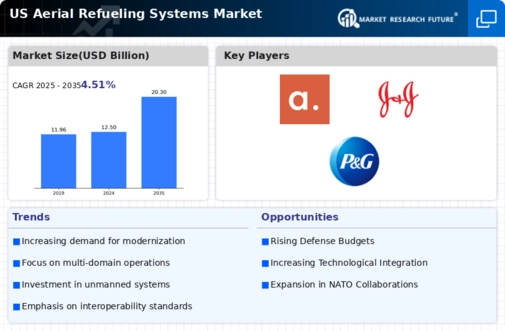Advancements in Aerospace Technology
Technological innovations are reshaping the aerial refueling-systems market, enhancing efficiency and operational capabilities. The integration of advanced materials, automation, and digital systems is streamlining refueling processes. For instance, the development of boom and probe systems has improved the precision and speed of refueling operations. In 2025, the market is projected to grow at a CAGR of 5.5%, driven by these technological advancements. The aerial refueling-systems market is witnessing the introduction of smart refueling systems that can adapt to various aircraft types, thereby increasing versatility. This trend indicates a shift towards more sophisticated solutions that meet the evolving demands of modern warfare.
Growing Demand for Military Readiness
The aerial refueling-systems market is experiencing a surge in demand driven by the need for enhanced military readiness. As geopolitical tensions rise, the U.S. military prioritizes maintaining a robust operational capability. This has led to increased investments in aerial refueling systems, which are essential for extending the range and endurance of military aircraft. In 2025, the U.S. defense budget allocates approximately $700 billion, with a significant portion directed towards upgrading aerial refueling capabilities. The emphasis on rapid deployment and sustained air operations necessitates advanced refueling systems, thereby propelling market growth. The aerial refueling-systems market is thus positioned to benefit from this heightened focus on military preparedness.
Rising Demand for Multi-Role Aircraft
The increasing demand for multi-role aircraft is significantly impacting the aerial refueling-systems market. As military forces adopt versatile platforms capable of performing various missions, the need for efficient refueling systems becomes paramount. Multi-role aircraft require robust aerial refueling capabilities to maximize their operational range and effectiveness. In 2025, the market is expected to see a rise in orders for multi-role aircraft, which will subsequently drive the demand for compatible refueling systems. The aerial refueling-systems market is thus poised to capitalize on this trend, as military planners recognize the strategic advantages of having adaptable and well-supported aircraft in their fleets.
Strategic Partnerships and Collaborations
The aerial refueling-systems market is increasingly characterized by strategic partnerships among defense contractors, government agencies, and technology firms. These collaborations aim to leverage expertise and resources to develop cutting-edge refueling systems. In 2025, several key partnerships are expected to emerge, focusing on joint research and development initiatives. Such alliances not only enhance innovation but also facilitate the sharing of costs and risks associated with new technologies. The aerial refueling-systems market benefits from these synergies, as they lead to the creation of more effective and reliable refueling solutions. This collaborative approach is likely to accelerate the pace of advancements in the market.
Increased Focus on Air Force Modernization
The modernization of the U.S. Air Force is a critical driver for the aerial refueling-systems market. As the Air Force seeks to upgrade its fleet and capabilities, there is a corresponding need for advanced refueling systems that can support next-generation aircraft. The U.S. Air Force's investment in modernization programs is projected to exceed $200 billion over the next decade, with a substantial portion allocated to aerial refueling initiatives. This focus on modernization not only enhances operational effectiveness but also ensures that the aerial refueling-systems market remains at the forefront of technological advancements. The integration of new refueling systems is essential for maintaining air superiority.














Leave a Comment